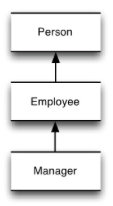A brief introduction to Domain Modelling
The content of this article is drawn from A brief introduction to Domain Modeling (McLeod 2009). Content has been simplified and streamlined. You can read the original here
What is a domain model?
an abstraction (a model) of an area of interest (domain).
Domain models give a high-level overview of the entities that make up a particular area of interest, and the links between them.
What is a domain model not?
A domain model is not a full-featured logical description of a database schema or a program structure.
It is chiefly a way to get a broad-brush overview of an area of interest, and may be used to start developing more complex models (such as database schema).
Can you show me a domain model?
Sure. Here's a simple domain model of a small business' employee structure:

How can I build a domain model?
Building a domain model gets harder as the domain gets more complex. Since you decide what does and does not belong in a domain, your model will change over time. In an Agile process it is usual for the domain model to be rebuilt many times.
To build simple domain model:
- Entities (sometimes called 'unique concepts' or 'business objects') are represented by rectangles.
- An arrow between entities indicates that one entity is a subtype of another. For example, in the diagram above, all Employees are also People, and all Managers are also Employees (and so also People). So Person is a subtype of both Employee and Manager.
- A simple line between entities indicates that they are related in some other way.
There are many more ways of indicating more complex relationships between entities. These become necessary as domain models become more complex. Most of these rules are part of an accepted design language, UML (Unified Modelling Language). You do not need to be proficient in all aspects of UML to build clear domain models.
When might I use domain models?
Domain modelling is one of the first steps in designing software. In an Agile process, an accurate domain model guides how to translate user stories into an implementable class structure. More generally, domain models are also used in systems theory to model complexity.
Wrapping up
- A domain model is an abstraction of an area of interest.
- They consist of entities (in rectangles) and the relationships between them (as lines and arrows, and more generally in Unified Markup Language).
- Domain models are one step in translating from user stories to class structures.